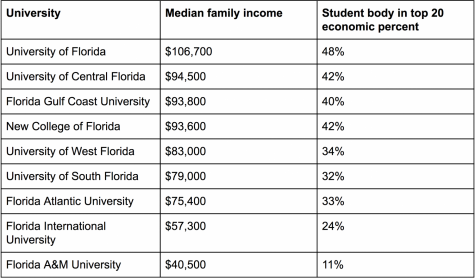FAU student population is mostly middle, lower income
Although FAU is surrounded by million dollar homes and cars in Boca Raton, its students tend to come from a different demographic.
The majority of FAU students come from middle and lower income families, but a third of the student body is upper class. Illustration by Joey Sena
October 11, 2018
This story is a part of our print issue on diversity, which looks at differences in beliefs, race, gender/sexuality, age, disabilities, and social class among FAU students and faculty.
While Boca Raton is known for its wealthy residents, most of the FAU student body comes from a different background.
The majority of FAU students are from middle class families. The average FAU student’s family makes about $75,400 per year, reported the New York Times. This is $14,000 above the U.S. median household income, according to Business Insider, but still within the middle class.
Despite this, the university does have its extremes — a third of students come from families whose incomes put them in the top 20 percent of the economy, and another 10 percent come from the bottom 20.
Kuntal Banerjee, an FAU economics professor, believes that “our university actually caters to middle and lower income families, working people, which is a positive thing.”
Income divide
FAU is one of Florida’s 12 public universities, which contributes to the middle-class nature of its students — the “rich and famous” of Boca Raton don’t typically send their children to FAU, Banerjee said. They go to private schools instead, where those from low income families also attend, but are covered by extensive scholarships that a richer school would have the funds to hand out, he added.
Banerjee said the main divide he sees on campus is between college students who have to work to cover their bills and those who don’t.
“The reason they are doing it is in most cases not because they want to earn an extra buck even though they’re doing well, but they probably need that job,” he said.
When he taught at private Ivy League college Cornell, Banerjee said he didn’t see a single student who was working on the side. At FAU, however, he sees them all the time, especially the ones taking night classes.
Night classes, as well as online classes, are one way that FAU caters to the working population. Many people work from 9 a.m.-5 p.m., and can’t be “day-time scholars” like the typical college student, he said.
“Students that work full time typically self-select to take night classes … but I can see how hard that is …” he said. “if you work from 5-9 in the day, do you think you can sit for three hours? I don’t think you can. It’s just not feasible.”
Although, there are downsides to night classes as well. All of the time slots are three hours long, but only take place once a week, since many students live as far away as Miami and can’t come to campus very often.
He added that despite this, night classes still give students a chance who otherwise wouldn’t have time to pursue their degree. Cornell didn’t even offer night classes, he said.
Money Matters
FAU is home to Federal Work Study programs, where eligible students from lower income backgrounds are able to work part time on campus to help cover their tuition costs. Out of FAU’s 30,000 or so students, there were 320 students in the program in 2017-18, Assistant Vice President for Financial Aid Tracy Boulukos said.
And the university’s Financial Aid office aids students in setting up tuition payment plans. In 2017 there were 36,289 visits to the Financial Aid office, and so far in 2018 there have been 32,092 visits.
FAU also gives out regular scholarships. For the 2017-18 school year, 31,171 grants or scholarships were awarded, with 16,110 students receiving at least one each. That’s over half of FAU’s student population.
The scholarships and grants are given out based on data from the Free Application for Federal Student Aid (FAFSA). The number of FAFSA applications saw a decline at FAU from 2014-17, and the number of students receiving need-based awards did as well. But this trend “significantly reversed” in the 2017-18 school year with the implementation of “prior-prior FAFSA,” which makes tax data required by FAFSA more accessible, Boulukos said.
“Families that previously would consider themselves unable to complete the FAFSA early due to the lack of final tax data now are more likely to have the data needed to complete the FAFSA readily available,” she said.
FAFSA data is also necessary to take out student loans. About 35 percent of undergrad students are taking out student loans this year, and 38 percent of grad students, she added.
University support
Some programs make sure that students don’t have to pay tuition at all. One is the FAU Kelly/Strul Emerging Scholars Program, which provides first-generation college students with full tuition and housing so they can graduate with little or no debt.
FAU has 5,482 first-generation college students, according to university public records custodian Rachelle Hollingsworth. That’s about 1/6 of the school’s population. So FAU set up a program called RISE, or Reaching Individual Success and Empowerment in 2015.
The program recruits first-generation students and has 150 members as of fall 2018. It helps its members find financial assistance, since most first-generation college students come from low-income households.
First-generation college students face challenges that average students don’t, Director of First-Generation Student Success Ron Oliver said.
“Research tells us that 25% [of] first-generation students drop-out within their first year of college; many within their first semester … They don’t have a support system at home that can help them navigate all of our processes or through the academic journey …” he said. “They oftentimes attended lower performing high schools that do not offer honors or advanced placement and, therefore, are not as academically prepared.”
To help prevent that 25 percent from dropping out, RISE provides mentoring, academic support, and internships for its members.
These students are more likely to get flagged by FAFSA for records verification, which can discourage them from going through with the process. They also typically work one to two jobs at a time, which means they don’t have as much time to study, Oliver added.
How FAU ranks
Overall, FAU’s tuition rate is cheaper than most, which is part of what draws students to the school, Banerjee said. Around 52 percent of FAU students graduate with debt, and the average is $23,504 per graduate. This is lower than the national average: 57 percent of students graduate with an average debt of $29,000, Boulukos said.
Banerjee said that FAU’s pricings and programs that cater toward middle and lower-class populations are ultimately a case of supply and demand — the university shapes its services around its student body’s economic background.
He added, “If you ask me whether or not it’s a conscious choice or whether we [do] that because the market needed us to, I don’t know that answer. But I think it’s a little bit of both.”
Bankroll Breakdown
FAU’s median family income is near the bottom of the list when it comes to the rest of the state’s public universities.

*Information courtesy of the New York Times. Data on Florida Polytechnic University. Florida State University, and the University of North Florida was not available as of publication time.*
Hope Dean is the managing editor of the University Press. For information regarding this or other stories, email [email protected].
















